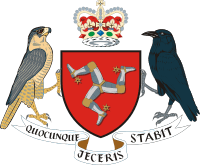Coat of arms of the Isle of Man facts for kids
Quick facts for kids The Arms of Her Majesty in right of the Isle of Man |
|
|---|---|
 |
|
| Armiger | Queen Elizabeth II, Lord of Mann |
| Adopted | 1996 |
| Crest | Ensigning the Shield of Arms an imperial crown proper |
| Blazon | Gules a triskele argent garnished and spurred Or |
| Supporters | Dexter a peregrine falcon and sinister a raven both proper |
| Motto | Quocunque jeceris stabit |
The coat of arms of the Isle of Man is the official symbol of the Isle of Man. It is also known as "The Arms of Her Majesty in right of the Isle of Man". This is because the Isle of Man is a Crown dependency, which means it belongs to the British Crown. The current design was officially adopted on 12 July 1996.
Contents
History of the Isle of Man Coat of Arms
The current coat of arms was given by Queen Elizabeth II, who is also known as the Lord of Mann. This happened on 12 July 1996. The design is based on the island's very old traditional arms. It has a special design that looks the same if you turn it around.
The traditional arms of the Isle of Man are very old, going back to the 13th century. These arms are recorded in old books from England and France. One old description from the Camden Roll says the arms are: "red, three bent legs in armour, joined at the top of the thighs, silver."
What the Symbols Mean
The Shield (Escutcheon)

The main part of the coat of arms is the shield. On the shield, you see a symbol called a triskele. It looks like three legs joined together in the middle. The legs are silver, and their spurs (the pointy parts) are gold, all on a red background.
The triskele is a very old symbol. It has three parts that spread out from a center point. You can find this symbol on the Isle of Man and also on the island of Sicily. In the Manx language, the triskele is called tre cassyn, which means "the three legs." This symbol has been linked to the Isle of Man since at least the 13th century.
No one knows for sure how the tre cassyn became the island's symbol. Some people think it came from the Sicilian triskele. Another idea is that it became popular in the 13th century. At that time, the King of Scotland, Alexander III, gained control of the Isle of Man. He might have used the triskele for his new island.
You can see early examples of the tre cassyn on the Manx Sword of State. This sword is very old, possibly from the 15th century. Another example is on a stone cross from the 14th century in Maughold churchyard. In early pictures, the legs usually run clockwise. Later on, they are shown running in both directions.
The Animals (Supporters)
On either side of the shield, there are two animals. These are called "supporters."
- The animal on the right side (from the shield's point of view) is a peregrine falcon. This bird is important because of King John I of Mann. In 1405, he was given the Isle of Man. But he had to promise loyalty to the English King and give two peregrine falcons to the King on every Coronation Day. This tradition continued for many years.
- The animal on the left side is a raven. Ravens are important in Norse mythology, which is part of the island's Viking history. The main Norse god, Odin, was often shown with two ravens.
The Motto
Below the shield, there is a ribbon with a motto. The motto is quocunque jeceris stabit. This is Latin and means: "whichever way you throw it, it will stand." This motto first appeared on Manx coins in 1668. It is thought that the motto became linked to the three legs symbol because of these coins.
Related pages
- List of coats of arms of the United Kingdom and dependencies
- Flag of the Isle of Man
Images for kids
See also
 In Spanish: Escudo de la Isla de Man para niños
In Spanish: Escudo de la Isla de Man para niños




